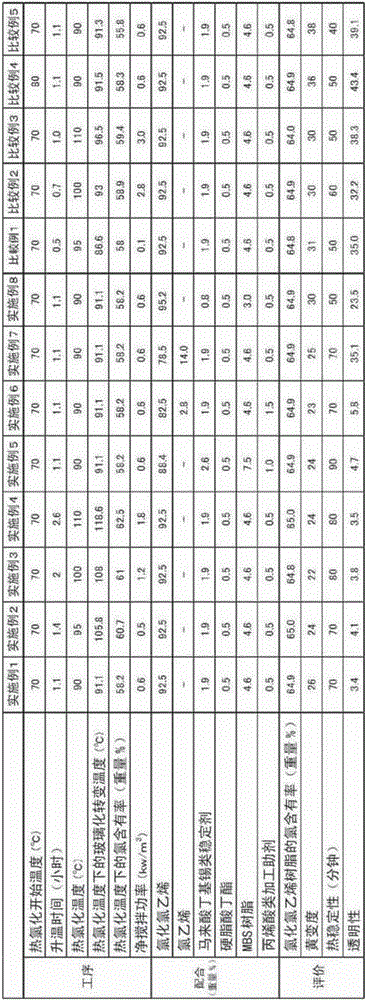Production method for chlorinated vinyl chloride resin
A technology of chlorinated vinyl chloride and a manufacturing method, which is applied to the manufacturing field of chlorinated vinyl chloride resins, and can solve the problems of poor heat resistance stability, no control, and inability to obtain transparent molded products.
- Summary
- Abstract
- Description
- Claims
- Application Information
AI Technical Summary
Problems solved by technology
Method used
Image
Examples
Embodiment 1
[0075] Put 200 kg of deionized water and 56 kg of vinyl chloride resin with an average degree of polymerization of 600 into a glass-lined reaction container with an internal volume of 300 liters, stir to disperse the vinyl chloride resin in water to form a water suspension state, and then heat the inside of the reaction container Instead, the aqueous suspension was warmed to 70°C.
[0076] Then, after reducing the pressure in the reaction vessel to remove oxygen (oxygen content 100 ppm), chlorine (oxygen content 50 ppm) was introduced so that the chlorine partial pressure was 0.4 MPa to start thermal chlorination (chlorination start temperature 70° C.).
[0077] Then, the temperature was raised to 90° C. over 1.1 hours so as to reach a temperature not higher than the glass transition temperature of the partially chlorinated vinyl chloride resin.
[0078] In addition, the glass transition temperature of a partially chlorinated vinyl chloride resin is calculated|required by DSC ...
Embodiment 2
[0086] Put 200 kg of deionized water and 56 kg of vinyl chloride resin with an average degree of polymerization of 600 into a glass-lined reaction container with an internal volume of 300 liters, stir to disperse the vinyl chloride resin in water to form a water suspension state, and then heat the inside of the reaction container Instead, the aqueous suspension was warmed to 70°C.
[0087] Then, after reducing the pressure in the reaction vessel to remove oxygen (oxygen content 100 ppm), chlorine (oxygen content 50 ppm) was introduced so that the chlorine partial pressure was 0.4 MPa to start thermal chlorination (chlorination start temperature 70° C.).
[0088] Then, the temperature was raised to 95° C. over 1.4 hours so as to reach a temperature not higher than the glass transition temperature of the partially chlorinated vinyl chloride resin.
[0089]Thereafter, after the chlorine content of the partially chlorinated vinyl chloride resin was 60.7% by weight, the temperature...
Embodiment 3
[0095] Put 200 kg of deionized water and 56 kg of vinyl chloride resin with an average degree of polymerization of 600 into a glass-lined reaction container with an internal volume of 300 liters, stir to disperse the vinyl chloride resin in water to form a water suspension state, and then heat the inside of the reaction container Instead, the aqueous suspension was warmed to 70°C.
[0096] Then, after reducing the pressure in the reaction vessel to remove oxygen (oxygen content 100 ppm), chlorine (oxygen content 50 ppm) was introduced so that the chlorine partial pressure was 0.4 MPa to start thermal chlorination (chlorination start temperature 70° C.).
[0097] Then, the temperature was raised to 100° C. over 2.0 hours so as to reach a temperature not higher than the glass transition temperature of the partially chlorinated vinyl chloride resin.
[0098] In addition, the glass transition temperature of a partially chlorinated vinyl chloride resin is calculated|required by DSC...
PUM
| Property | Measurement | Unit |
|---|---|---|
| glass transition temperature | aaaaa | aaaaa |
| glass transition temperature | aaaaa | aaaaa |
| glass transition temperature | aaaaa | aaaaa |
Abstract
Description
Claims
Application Information
 Login to View More
Login to View More - Generate Ideas
- Intellectual Property
- Life Sciences
- Materials
- Tech Scout
- Unparalleled Data Quality
- Higher Quality Content
- 60% Fewer Hallucinations
Browse by: Latest US Patents, China's latest patents, Technical Efficacy Thesaurus, Application Domain, Technology Topic, Popular Technical Reports.
© 2025 PatSnap. All rights reserved.Legal|Privacy policy|Modern Slavery Act Transparency Statement|Sitemap|About US| Contact US: help@patsnap.com

